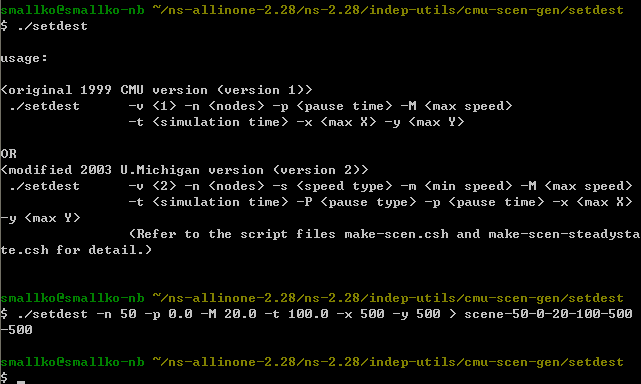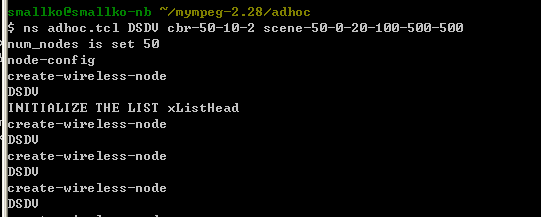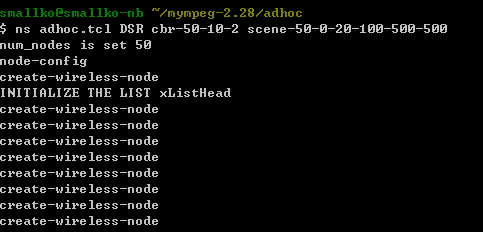Performance Evaluation of DSDV, AODV, and DSR
In this report, I just show the simulation scripts to compare theperformance of DSDV, AODV, and DSR. More information about these adhoc routing protocols can be found on the Internet orbooks.
这段代码直接拷贝会出现如下问题:
num_nodes is set 50
invalid command name "-llType"
while executing
"-llType $val(ll) /"
(file "adhoc.tcl" line 48)
貌似是空格用了tab键什么的,所以代码直接到http://140.116.72.80/~smallko/ns2/adhoc_routing.htm
上面去复制比较保险。
(TCL script --- adhoc.tcl)
if {$argc !=3} { puts "Usage: ns adhoc.tcl Routing_Protocol Traffic_Pattern Scene_Pattern " puts "Example:ns adhoc.tcl DSDV cbr-50-10-8 scene-50-0-20" exit } set par1 [lindex $argv 0] set par2 [lindex $argv 1] set par3 [lindex $argv 2] set val(chan) Channel/WirelessChannel ;# channel type set val(prop) Propagation/TwoRayGround ;# radio-propagationmodel set val(netif) Phy/WirelessPhy ;# network interface type set val(mac) Mac/802_11 ;# MAC type if { $par1=="DSR"} { set val(ifq) CMUPriQueue } else { set val(ifq) Queue/DropTail/PriQueue ;# interface queue type } set val(ll) LL ;# link layer type set val(ant) Antenna/OmniAntenna ;# antenna model set val(ifqlen) 50 ;# max packet in ifq set val(rp) $par1 ;# routing protocol set val(x) 500 set val(y) 500 set val(seed) 0.0 set val(tr) temp.tr set val(nn) 50 set val(cp) $par2 set val(sc) $par3 set val(stop) 100.0 set ns_ [new Simulator] set tracefd [open $val(tr) w] $ns_ trace-all $tracefd $ns_ use-newtrace set topo [new Topography] $topo load_flatgrid $val(x) $val(y) set god_ [create-god $val(nn)] set chan_1_ [new $val(chan)] $ns_ node-config -adhocRouting $val(rp) / -llType $val(ll) / -macType $val(mac) / -ifqType $val(ifq) / -ifqLen $val(ifqlen) / -antType $val(ant) / -propType $val(prop) / -phyType $val(netif) / -channel $chan_1_ / -topoInstance $topo / -agentTrace ON / -routerTrace ON / -macTrace OFF for {set i 0} {$i < $val(nn) } {incr i} { set node_($i) [$ns_ node] $node_($i) random-motion 0 ;# disable random motion } puts "Loading connection pattern..." source $val(cp) puts "Loading scenario file..." source $val(sc) for {set i 0} {$i < $val(nn) } {incr i} { $ns_ initial_node_pos $node_($i) 20 } for {set i 0} {$i < $val(nn) } {incr i} { $ns_ at $val(stop).000000001 "$node_($i) reset"; } $ns_ at $val(stop).000000001 "puts /"NS EXITING.../"; $ns_ halt" puts "Start Simulation..." $ns_ run
Performance metric: Packet Delivery fraction (The ratio of the data packets delivered to the destinations to those generated by the sources)
(AWK paring program --- getRatio.awk )
BEGIN { sendLine = 0; recvLine = 0; fowardLine = 0; } $0 ~/^s.* AGT/ { sendLine ++ ; } $0 ~/^r.* AGT/ { recvLine ++ ; } $0 ~/^f.* RTR/ { fowardLine ++ ; } END { printf "cbr s:%d r:%d, r/s Ratio:%.4f, f:%d /n", sendLine, recvLine, (recvLine/sendLine),fowardLine; }
Before running simulation, we have to use the tools to generate the traffic and scenario patterns.
1. Traffic pattern (change the path to ~ns/indep-utils/cmu-scen-gen )
In this example, traffic models were generated for 50 nodes with CBR traffic sources, with maximum connections of 10 at a rate of 8kbps.
(-rate 2.0: in one second, 2 packets are generated. The packet size is 512 byte. Therefore the rate is 2*512*8=8kbps)
2. Scenario pattern (change the path to ~ns/indep-utils/cmu-scen-gen )
In this example, mobility models are created for the simulations using 50 nodes, with pause time of 0 seconds, maximum speed of 20m/s, topology boundary of 500x500 and simulation time of 100 secs .
After creating the traffic and scenario pattern files, copy them to the place where you put the adhoc.tcl .
Start Running Simulation
1. DSDV
Parse the result
1. AODV
2. DSR
The explanation for the results can be found at reference 1.
Reference
1. http://www.cs.utk.edu/~gupta/Adhoc.doc
2. http://www.ptpress.com.cn/books/Book_Information.asp?BID=11867
来源:http://140.116.72.80/~smallko/ns2/adhoc_routing.htm







